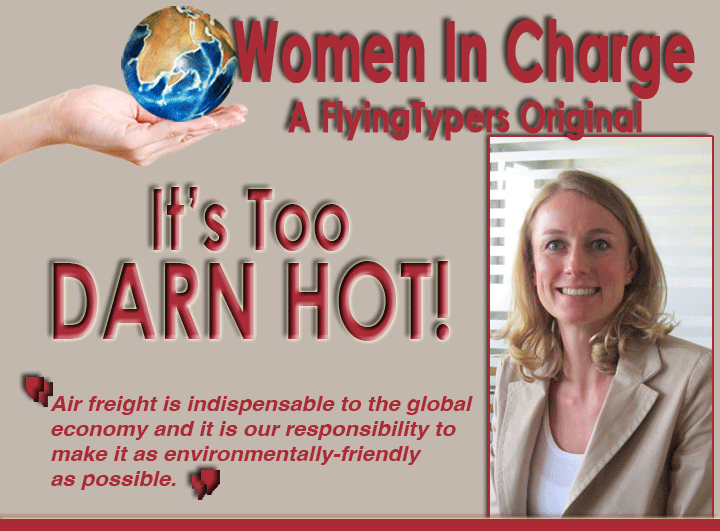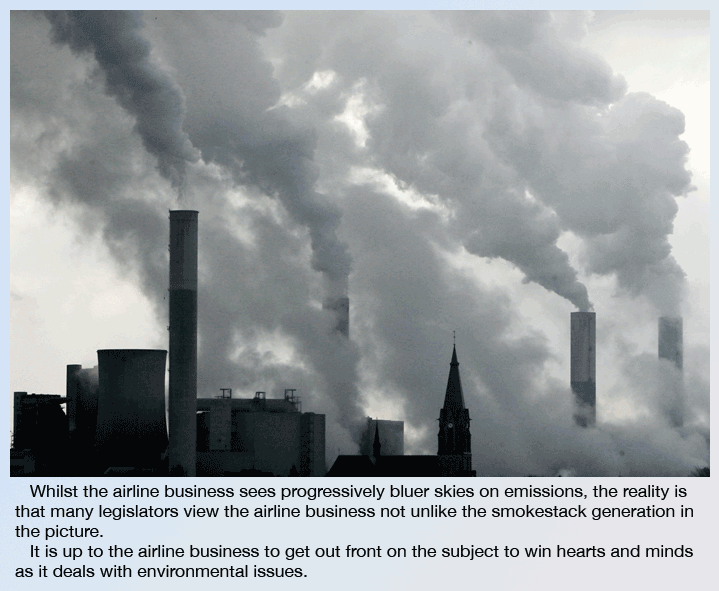
The message for July is
that the world is warming up, although in many climes, those words may
not be news at all.
But according to TimeforChange.org, “Global
warming is caused by the emission of greenhouse gases,” of which
“72 percent of the totally emitted greenhouse gases is carbon dioxide
(CO2).” With CO2 emissions increasing 3 percent each year, and with
emissions having drastically increased in the last 50 years, we have passed
the point where we should have taken action, and our excuses are limited—if
they can be considered morally acceptable at all.
 |
Earlier in June, Lufthansa Cargo launched
its Fourth Environmental Conference at the Städel Museum in Frankfurt,
Germany, with 150 logistics experts conferring to strategize how best
to move forward with this year’s motto “More Logistics and
Less CO2.”
FlyingTypers sat
down with Lufthansa Cargo’s Head of Environmental Management Bettina
Jansen, who in 2013 told FlyingTypers, “Air freight is indispensable
to the global economy and it is our responsibility to make it as environmentally-friendly
as possible.” Three years before that, in 2010, when Head of Security
and Environmental Management Harald Zielinski stated Lufthansa’s
goal to be “the world’s most environmentally friendly cargo
carrier,” Ms. Jansen added a more specific, focused goal: “To
reduce the specific carbon dioxide emissions 25 percent by 2020.”
We are now five years closer to that due date and wondering how far along
Lufthansa Cargo has come.
“By 2020, we aim to reduce our specific
CO2 emissions by 25 percent compared to 2005. Last year we had already
reached 15.8 percentage points. It is an achievement that we are proud
of and that motivates us to keep making improvements,” said Ms.
Jansen.
“Out of our 50 Fuel-Efficiency measures
some are in the implementation phase, which will lead to further reduction
of weight (e.g. lightweight pallets) and technical measures (e.g. Fanblade-Recontouring).
All aim to fly more efficiently and in accordance to cause less CO2.
“We promote environmental issues for
airfreight and are therefore involved in several green boards, such as
the IATA Working Group, Air Carbon Cargo Footprint (ACCF), which has developed
a recommended practice to measure CO2 emissions caused by airfreight.
At the moment a harmonization is taking place with further methods, hopefully
until 2016. We support this process.
“With the conference we want to provide
a platform for our customers as well as politicians and scientists, where
we can meet and discuss new developments in the area of airfreight, logistics,
and environment. There has been very positive feedback about our extraordinary
locations, professional speeches, and pleasing penal discussions, which
confirms to us that the interest in this kind of conferences is unabated.
“With our cargo climate care award,
we want to honor special commitment to the environment of our employees
and customers, which goes beyond the normal everyday routine. We think
that we thus motivate our employees and strengthen cooperation with our
customers. The ceremony is always a highlight of our conference,”
said Ms. Jansen.
Lufthansa Cargo has come a long way since
it first set out to become more environmentally friendly. According to
Ms. Jansen, “in 2008 we successfully implemented an environmental
management system according to ISO 14001 in Frankfurt.
“In 2009 we started a roll-out, beginning
in Germany. This year we gained the approval on an external audit in the
Americas. By end of 2015 we aim to be certified worldwide. This guarantees
a ‘Green Standard’ in each station and process. Subsidiaries
will follow—Jettainer is already successfully certified.
“Committed employees and successful
projects (e.g. in the purchasing process) confirm to us the success of
the system.”
Earlier this year in April Lufthansa announced
it would be delaying the planned investment by Lufthansa Cargo in their
new cargo center, ‘LCCneo,’ by at least two years. LCCneo
being a crucial and significant component of the ‘Lufthansa Cargo
2020’ strategy for the future, FlyingTypers wonders how
the delay will affect Lufthansa reaching their projected goals.
“The ‘LCCneo’ remains
a key pillar of our ‘Lufthansa Cargo 2020’ strategy, and the
program will still be implemented at full steam. We will now evaluate
what measures we can take to modernize the LCC on a temporary basis. We
have a functioning LCC and an excellent team. We are certain that we will
continue to offer our clients top-quality service,” said Ms. Jansen.
In terms of ongoing projects and using Lufthansa’s
established facilities to propel their environmental efforts forward,
“the optimization of our processes on the ground is our daily business,
also in our currently used facilities. The purchase of new energy-efficient
forklifts and the investment in LED lighting on our outer areas are just
a few examples.
“The research project Green Logistics,
which we have worked out for five years together with relevant partners
in the logistics industry, such as the Fraunhofer Institute, DB Schenker,
DHL, Fiege Vanderlande, and UPS, is completed. The project has developed
an assessment method for the whole logistics chain—considering transport
via different carriers (road, rail air, and sea), transshipment, and warehousing
(including logistics real estates and intra-logistics),” said Ms.
Jansen.
With efforts like the Climate Care Conference,
Lufthansa Cargo is proudly at the forefront of forwarding environmentalism
and awareness within the cargo community, and Bettina believes there are
some basic moves everyone in the industry can make to contribute to the
cause.
“The most important thing [for those
in the cargo industry] is of course to comply with applicable law. The
biggest lever you have to reduce the impact on the environment is to use
new technologies. Therefore we invest the B-777F, the freighter with today’s
best environmental performance.
“Moreover it is worth it to check
processes for optimization potential on a regular basis and to integrate
the topic of environment in the decisionmaking process. At last, it is
important to have staff and management who take the issue seriously and
communicate honestly on board,” said Ms. Jansen.
Finally, FlyingTypers was curious
as to how Ms. Jansen landed in her particular role within the cargo industry,
and specifically in regards to environmentalism.
“My studies of physics are a good
basis for the job as environmental manager here at Lufthansa Cargo. Regular
internal meetings with environmental coordinators of LH Cargo and the
Group as well as the participation in external working groups with the
industry (BDL, IATA . . .) enable me to keep up with current trends and
to identify new issues.
“At the recent G7 summit, targets
for CO2 reduction, objectives regarding alternative energy, and the importance
of the supply chain were main topics. It was these exact topics that were
discussed at our Cargo Climate Care Conference. Therefore, I am convinced
that we are on the right track,” said Ms. Jansen.
Flossie Arend
|





